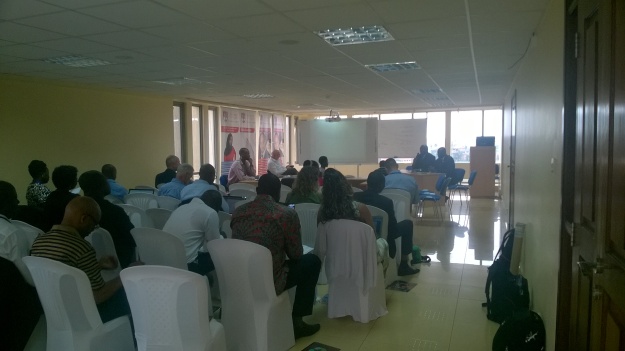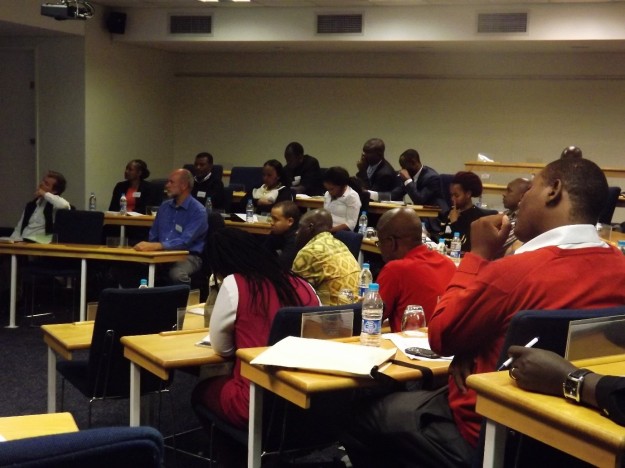The SAMSET Project hosted a continuing professional development course at Victoria University in Kampala, Uganda from the 7th – 11th November 2016. As shown in the previous post, the urban energy management issues present today in Kampala make the city an appropriate place to discuss the future of sustainable urban energy transitions.
The Hon. Dr Chris Baryomunsi, Minister of State for Housing, addressing the opening of the CPD Course. Image: Daniel Kerr
The course was opened with an address from the Hon. Dr Chris Baryomunsi, who gave an address on the overarching issues facing urban Kampala today, include economic growth, population growth and land management. The first plenary day of the course focused on resource efficiency in energy planning and management in the urban sphere. The presentations on this day focused on the mandate that municipal officials have in the energy space (or lack thereof) and a focused discussion on the importance of data in energy planning, as well as case studies of successful initiatives in other Sub-Saharan African cities and the challenges they faced. The city of Cape Town was presented as a successful sustainable transitions case study, with the presentation from Sumaya Mohamed from the City of Cape Town Energy Authority detailing a number of the successful interventions the city has implemented, including electrification of “backyarder” properties and the development of the metropolitan bus transit system. The place of data was also highlighted through Adrian Stone from Sustainable Energy Africa’s exercise, encouraging participants to analyse and discuss data from a recent Jinja state of energy survey themselves.
The second day of the course focused on participation and key stakeholders in energy management, and methods to identify the stakeholders through network mapping, as well as to what extent these stakeholders and able (or willing) to advocate for energy transitions. Presentations on this day focused on the realities of bringing sustainable planning into action, whilst managing competing demands, with experiences and cases from the SAMSET Ghanaian partner municipalities, Awutu Senya East and Ga East, as well as from the Ugandan partner municipalities Jinja and Kasese. The closing keynote was presented by David Kasimbazi, head of the Centre for Urban Governance and Development at Victoria University, on the definitions of governance and good governance, and how this affects sustainable energy transitions in cities.
Urban energy budgetary planning group session, led by Gamos. Image: Daniel Kerr
The third day of the course focused on the place that policy and regulatory frameworks can have in sustainable urban energy transitions. Presentations focused both on high-level policy and regulatory mechanisms, as well as technology-specific interventions in the urban sphere. The morning presentation from Vincent Agaba of the Real Estate Agents of Uganda was particularly relevant, in offering a property developer’s perspective in the sustainable transitions space, and the definitions of enabling environments in the space for developers. The afternoon saw Simon Batchelor from Gamos conduct a Netmapping exercise, a tool which the organisation has developed over many years, to identify the key stakeholders in the urban energy space, both in the partner municipalities outside Uganda and in Jinja and Kasese, as well as within the city
Day four of the course was centred around the theme of “Build(ing) Resilience”, with presentations focusing on designing and building with people, as well as ensuring resilience in design and sustainability. Key themes covered in the presentations included environmentally conscious design, with cases from local as well as international buildings, presented by Mark Olweny of Uganda Martyrs University, as well as innovative outreach initiatives for building support for sustainable energy transitions, and the use of the tourism sector as a driver of sustainable transitions, presented by Herbert Candia of Uganda Martyrs University.
The SAMSET Project will be hosting a third and final CPD course in Accra, Ghana from the 26th – 30th June 2017. More information on the course will be available both on this blog, as well as the project website, and the project Twitter.
Daniel Kerr, UCL Energy Institute







